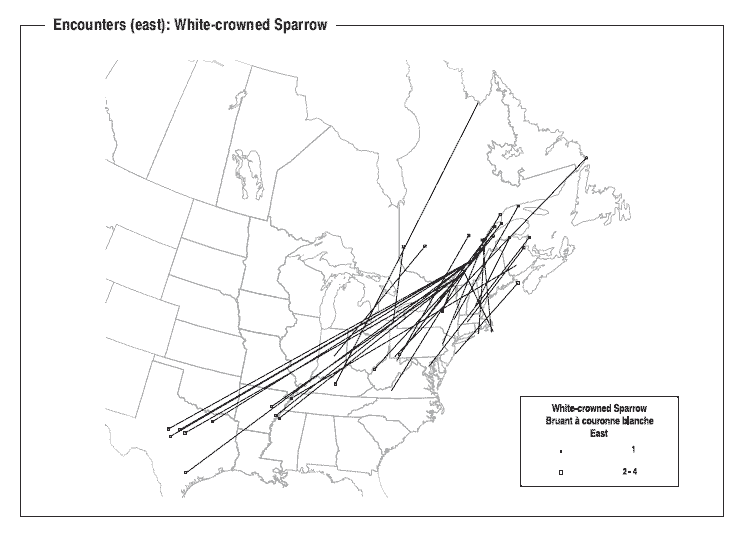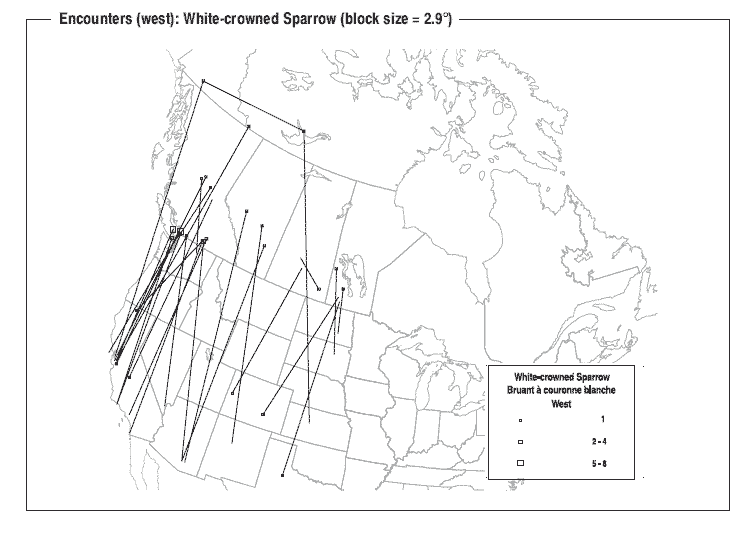There are five subspecies of White-crowned Sparrow, and in most parts of North America it is possible to see more than one subspecies during part of the year. Identification of subspecies is covered in the Sibley Guide to Birds and in Dunn et al. 1995. Maps of band recoveries (from the Canadian Atlas of Bird Banding) offer insight into, and raise questions about, two of these identification challenges: separating the two dark-lored subspecies, Mountain West vs. Eastern, and distinguishing Gambel’s (Western Taiga) birds among Eastern Taiga birds in the eastern states.
Mountain West vs. Eastern White-crowned Sparrows
The separation of Mountain West White-crowned Sparrows (Z. l. oriantha) and Eastern White-crowned Sparrows in winter and migration (Z. l. leucophrys) is based mostly on assumptions about range. The map below shows recoveries of banded White-crowned Sparrows either coming from or going to eastern Canada. All of these birds are presumably the eastern subspecies Z. l. leucophrys, but the banding records show that they travel far to the southwest in winter – often as far as central Texas.

The Mountain West subspecies Z. l. oriantha (which has dark lores like Eastern leucophrys) is assumed to account for the dark-lored birds wintering in west Texas, but it seems likely that at least some leucophrys are mixed in there. Eastern leucophrys should also be expected to overshoot at least occasionally to New Mexico, Arizona, and even California. In addition, Mountain West White-crowneds seem likely to stray east of their normal range and show up among leucophrys in central Texas or farther east. Identification is the real challenge, as these two subspecies have often been lumped by ornithologists who could not see any difference even when working with museum specimens! Winter range alone is not sufficient for identification. Calls and songs should provide a clue, and there are some subtle plumage differences that may prove reliable. All it needs is some diligent field study.
Gambel’s (Western taiga) vs. Eastern White-crowned Sparrows
Gambel’s (Western Taiga) White-crowned Sparrows Z. l. gambelii have pale lores and nest from the western side of Hudson Bay to Alaska, but all around the southern end of Hudson Bay into Quebec they intergrade with dark-lored Eastern Taiga birds Z. l. leucophrys. Across this wide intergrade zone the nesting birds are a mixture of dark-lored, pale-lored, and intermediate.
Gambel’s-type birds are reported annually (mostly in fall) in the northeastern states, and I have seen several in New Jersey and Massachusetts that looked very convincing for this subspecies. The problem is that, judging by the map below, true Gambel’s White-crowned Sparrow should be an extremely rare visitor to the northeast.

The map shows band recoveries of White-crowned Sparrows coming from or going to Western Canada – all Gambel’s – and they all follow a relatively strict north-south movement. It’s dangerous to generalize between species, of course, but it just doesn’t seem like these birds should show up in the east more often than, say, Harris’s Sparrow.
Vagrant gambelii from west of Hudson Bay or from Alaska undoubtedly do occur rarely in the east, but the vast majority of reported gambelii there must be merely pale-lored birds from the variable and mixed populations east of Hudson Bay. The status of pale-lored birds in northern Quebec well east of Hudson Bay is poorly-known, but they may occur there in small numbers. Further field work is needed to determine the range of pale-lored birds, and to look for any possible differences between these pale-lored Eastern birds and true Gambel’s from the west.
References:
Brewer, D., A. W. Diamond, E. J. Woodsworth, B. T. Collins, and E. H. Dunn. 2000. Canadian Atlas of Bird Banding. Volume 1: Doves, Cuckoos, and Hummingbirds through Passerines, 1921–1995. Canadian Wildlife Service. pdf here: http://dsp-psd.pwgsc.gc.ca/Collection/CW69-15-1-1-2000E.pdf
Dunn, J.L., K.L. Garrett, and J.K. Alderfer. 1995. White-crowned Sparrow Subspecies: Identification and Distribution. Birding 27:182-200.


Hi David,
Interested in your thoughts on this bird I saw in Nov 2008 here in Connecticut. I have seen a few pale lored birds here in the east and assumed that they were one of the western types but after your article I am certainly wondering. This bird however has a distinctly yellow bill to my eye. What else should we be looking for do you think? http://underclearskies.com/2008/11/17/possible-western-white-crowned-sparrow-sherwood-island-111608/
Luke, Your bird certainly looks yellow-billed and pale-lored, and the only other things to look for are very subtle and subjective. I’m working on a more in-depth page on White-crowned Sparrow subspecies, which will have more details, but the quick response is that there are apparently pale-lored and yellow-billed individuals nesting east to Quebec, and a variable mix all the way from there to Manitoba, so when birds like yours show up in the northeast it’s OK to call them “gambelii-type” but it’s unlikely that they’re from the “west”. I don’t know if birds like this would be distinguishable from true western gambelii.
Three years later…
I’ve worked in northern Quebec and I’ve seen tons of White-crowned Sparrows and I’ve never seen pale-lored, orange-billed individuals during breeding season like I’ve seen in Colville Lake, Northwestern Territories during summer. During fall migration, I work at Tadoussac bird observatory (Quebec) and pay attention to most White-crowned Sparrows I see, searching for gambelli type. I’ve only seen one in October 2003 and another in December 2011 in St-Basile-le-Grand, near Montreal which is the same number of Harris Sparrow I had in the province. This is the last gambelli-like WCSP I had in Quebec:
http://www.pbase.com/dendroica/image/140236869
Samuel, Thanks very much for this contribution. It’s good to finally have some first-hand info from northern Québec, and also reassuring to know that you don’t see a wide variation in the nesting White-crowned Sparrows there. That means the gambelli-like birds being seen in Massachusetts and New Jersey, for example, must come from farther west.
Hi David…what an interesting bird.I have just seen and heard my first White Crowned Sparrow in my area.May 10 – 2013.
There have been Chipping Sparrows and others but never any of these that I know of.
I live in Huntsville Ontario not far from Algonquin Park.
Do you know if these birds are changing migration or maybe blown off course from some of these storms ? Or have I possibly been not noticing these birds ?
As Samuel points out, it’s very important to measure the actual frequency of Gambel’s-like birds within the breeding range of leucophrys. Another quantitative angle that is available to us is the seasonal distribution Gambel’s-like birds in the East–that is, the proportion of such birds among White-crowned Sparrows at different seasons. My impression from many years of studying White-crowned Sparrows in southern New England and on Long Island is that during the main flow of southbound migration in October, the vast majority of WC Sparrows resemble typical leucophrys, as expected. Hatching-year birds vary somewhat in loral darkness, but very, very few birds show any tendency toward yellow tones in the bill–and all those with orange-yellow bills are also pale-lored. Later, during winter, much smaller numbers of WC Sparrows are present here. Again, the correlation between loral pattern and bill color seems very strong (I can’t recall a yellow-billed bird with dark lores, either in fall or in winter).
Most interesting, however, is my perception that Gambel’s-like birds occur here at a much higher relative proportion in winter than in fall migration. Whereas such birds account for much less than one percent of fall White-crowns, they might account for as much as 10% of the few White-crowns we encounter during winter. This seasonal disparity would not be expected if these birds were variants drawn broadly from the range of leucorphrys, and, moreover, it is fully consistent with the well documented pattern in which western North American vagrants to the Northeast occur at higher relative frequency during winter than fall, compared to their commoner eastern North American relatives (e.g., Audubon’s vs. Myrtle Warblers, Western vs. Scarlet Tanagers, etc.).
I had white-crowned sparrows through the winter (western Kentucky), but I haven’t seen any since around mid-March until April 30, then again on May 5 and then again today, May 14. I know that we are in the winter range, but is it normal for it to still be here. I figured they had all migrated back to the north. As far as I can tell, it is just one bird.
Hi Mr. Sibley, I have a question.
What subspecies of White-crowned Sparrow would I expect to see in the Fraser Valley area of British Columbia, Canada? Thanks and great article!
David,
Thank you so much for your extraordinary work presenting information on bird behaviour, range, and identification. It is very much appreciated.
Here’s a yellow-billed, pale-lored White-crowned Sparrow that has been frequenting my bird feeder in southeastern Ontario, Canada since December 2020:
https://www.flickr.com/photos/paulbjones/50887544278/in/dateposted-public/
For what it’s worth, and after consultation with local experts, I’m naming it a Gambel’s (but understand that that is perhaps an indefinite label). With respect to the White-crowned banding and recapture data from western North America, it is interesting but I wonder if the sample size is to small to draw any firm convictions. For the number of banding data points, wouldn’t any western species that is a fall vagrant to the east show a similar pattern of non-occurrence out of range?